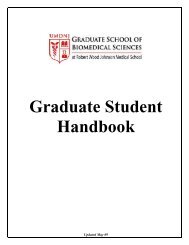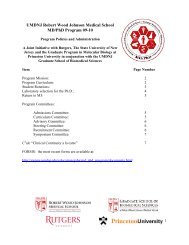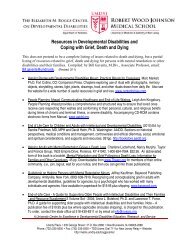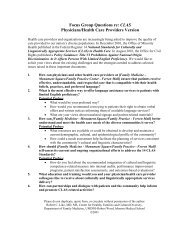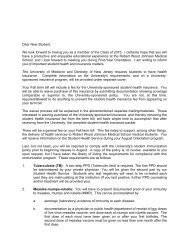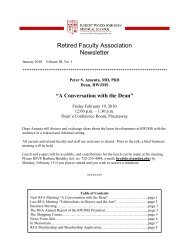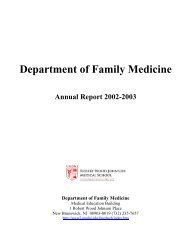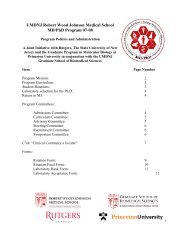Yolanda Cespedes Manuscript
Yolanda Cespedes Manuscript
Yolanda Cespedes Manuscript
Create successful ePaper yourself
Turn your PDF publications into a flip-book with our unique Google optimized e-Paper software.
Running Title: Cultural Discrepancy<br />
Cultural Discrepancy 1<br />
The Role of Cultural Discrepancy in Latino Adolescent Mental Health (5/25/09)<br />
<strong>Yolanda</strong> M. Céspedes, Ph.D.<br />
Childrens Hospital Los Angeles<br />
4650 Sunset Blvd. Mailstop #99<br />
Los Angeles, CA 90027<br />
Tel: 323-361-4308<br />
Email: ycespedes@chla.usc.edu<br />
<strong>Yolanda</strong> M. Céspedes, Ph.D. 1<br />
Stanley J. Huey, Jr., Ph.D. 2<br />
1 Childrens Hospital Los Angeles, Los Angeles, CA, U. S.<br />
2 University of Southern California, Los Angeles, CA, U.S.<br />
Reprint requests should be sent to Dr. <strong>Yolanda</strong> M. Céspedes, Childrens Hospital Los Angeles, 4650 Sunset Blvd. Mailstop<br />
#99, Los Angeles CA 90027 or Dr. Stanley J. Huey, Jr., University of Southern California, Department of Psychology<br />
SGM 501, 3620 S. McClintock Ave., Los Angeles CA 90089. Email: ycespedes@chla.usc.edu or hueyjr@usc.edu.
Abstract<br />
Cultural Discrepancy 2<br />
Adolescent Latinos report high rates of depressive symptomatology and suicidal behavior<br />
compared to youth of other ethnic backgrounds, however few studies have investigated how culture-<br />
specific mechanisms may contribute to these negative outcomes. Cultural process models argue that<br />
intercultural discrepancy between Latino youth and their immigrant caregivers contributes to poor<br />
mental health outcomes through its mediating effects on family functioning. This study contributed to<br />
findings from a previous test of this model (Céspedes & Huey, 2008) by comparing adolescents<br />
reporting high and low levels of cultural discrepancy on measures of family functioning, depression,<br />
and suicidality. Results showed that perceived youth-caregiver discrepancy in familism and<br />
marianismo beliefs were significantly associated with family dysfunction and negative mental health<br />
outcomes. Perceived discrepancy in machismo beliefs yielded no significant findings. Moderator<br />
analyses suggested that the relationship between familism discrepancy and suicidality may be more<br />
robust for females than for males. Treatment implications and directions for future research are<br />
discussed.<br />
Keywords: adolescent depression, adolescent suicidality, familism, machismo, marianismo
Introduction<br />
Cultural Discrepancy 3<br />
The present study is an expansion of previous research exploring the contributing role of cultural<br />
discrepancy to increased risk for depression among Latino adolescents (Céspedes & Huey, 2008).<br />
Prior results showed that the relationship between gender role discrepancy and depression was<br />
mediated by increases in family dysfunction (i.e., greater family conflict and reduced family cohesion).<br />
Moderator analyses indicated that gender role discrepancy effects were most pronounced for<br />
adolescent Latinas, although the interaction effect was only marginally significant. The present article<br />
sought to contribute further to this area of research by expanding the theoretical model in two ways: 1)<br />
by including an additional source of cultural discrepancy – familism beliefs, and 2) by evaluating the<br />
effects of cultural discrepancy on suicidal behavior. The present study also improved upon the<br />
research design used by Céspedes and Huey (2008) by recruiting a larger and more representative<br />
student sample. The data presented in this article represents only a subset of the full data collected.<br />
Depression, suicidal ideation, and suicide attempts are fairly common in the adolescent population,<br />
but reported at higher rates among Latino adolescents (Blazer, Kessler, McGonagle, & Swartz, 1994;<br />
Emslie, Weinberg, Rush, Adams, & Rintelmann, 1990; Joiner, Perez, Wagner, Berenson, & Marquina,<br />
2001; Lester & Anderson, 1992; Roberts & Chen, 1995; Roberts, Roberts, and Chen, 1997; Roberts &<br />
Sobhan, 1992; Twenge & Nolen-Hoeksema, 2002; Weinberg & Emslie, 1987). Indeed, a recent<br />
national survey of over 14,000 9 th through 12 th graders (Centers for Disease Control and Prevention,<br />
2008) showed that Latino adolescents were considerably more likely than African-American and<br />
Anglo-American adolescents to experience persistent sadness and hopelessness, seriously consider<br />
suicide, and make a suicide attempt. Among all students surveyed, Latinas consistently reported the<br />
highest rates of these behaviors.
Family Functioning<br />
Cultural Discrepancy 4<br />
Family conflict and low family cohesion are strongly linked to both depression (Asarnow,<br />
Carlson, & Guthrie, 1987; Cole & McPherson, 1993; Constantine, 2006; Cumsille & Epstein, 1994;<br />
Fendrich, Warner, & Weissman, 1990; Hops, Lewinsohn, Andrews, & Roberts, 1990; Kaslow, Rehm,<br />
& Siegel, 1984) and suicidality (Asarnow & Carlson, 1988; Carlton-Ford, Paikoff, & Brooks-Gunn,<br />
1991; Chioqueta & Stiles, 2007; Rubenstein, Heeren, Housman, Rubin, & Stechler, 1989) in samples<br />
of children, adolescents, and college students. Furthermore, depressed adolescents and adolescent<br />
suicide attempters report significantly higher levels of family conflict and lower levels of family<br />
cohesion than non-depressed/non-suicidal adolescents (De Wilde, Kienhorst, Diekstra, & Wolters,<br />
1993).<br />
The quality of parent-child interactions may be an important contributor to overall conflict and<br />
cohesion in the family, thereby impacting youth’s risk for subsequent depression or suicidality<br />
(Wagner, 1997). Indeed, adolescent suicide attempters frequently report conflict with parents as the<br />
primary cause of their suicide attempts (Miller, Chiles, & Barnes, 1982; Negron et al., 1997) and report<br />
significantly more conflict with parents/guardians than matched controls (Corder, Shorr, & Corder,<br />
1974). As family dysfunction may therefore be attributable to the quality of parent-child interactions,<br />
this study explored culturally-based sources of parent-child disagreement that may impact parent-child<br />
relationships.<br />
Clinical accounts suggest that family conflict results when Latino youth acculturate to the host<br />
culture more rapidly than their immigrant parents (Szapocznik et al., 1989; Zayas & Dyche, 1995).<br />
During the acculturation process, these youth adopt new attitudes, values, and behaviors that may be<br />
incompatible with the traditional beliefs of their parents and native culture, causing a cultural and<br />
generational gap between youth and parents. Although these processes are theorized to operate<br />
broadly in terms of acculturation status (Szapocznik et al., 1986), generational disparities may also
arise in connection with culturally-based family role and gender beliefs such as familismo,<br />
marianismo, and machismo.<br />
Cultural Discrepancy 5<br />
Familismo beliefs. The term familismo describes the strong emphasis placed on the family unit<br />
among Latinos. It captures the sense of support and reliance among family members (Baca Zinn,<br />
1994; Marín & Marín, 1991), as well as sentiments of mutual obligation, loyalty, and family unity<br />
(Cortes, 1995; Rodriguez & Kosloski, 1998; Sabogal, Marín, Otero-Sabogal, Marín, & Perez-Stable,<br />
1987). Familism incorporates a wide array of culturally-nuanced attitudes among Latinos, including<br />
beliefs that family members are obligated to assist one another when they are in need (Burgess, Locke,<br />
& Thomes, 1963) and that family members are obligated to remain in close proximity to each other<br />
(George, 1986). Steidel and Contreras (2003) describe four primary familismo beliefs: that the family<br />
comes before the individual, that family members should maintain strong emotional and physical<br />
bonds, that family members should support each other in times of need, and that family members<br />
should protect the family name and honor.<br />
Marianismo and machismo beliefs. The terms marianismo and machismo describe traditional sex<br />
role expectations commonly found in many Latin-American societies (Falicov, 1998). The term<br />
marianismo derives from Catholic representations of the Virgin Mary, who is venerated as a symbol of<br />
saintliness, self-sacrifice, and emotional suffering (Nieto, 1997; NietoGomez, 1997) and refers to the<br />
expectation for Latinas to be acquiescent, humble, and modest (Comas-Díaz, 1987). Within a<br />
marianismo conceptualization, Latinas are viewed as caretakers who are able to foster harmonious<br />
relationships with others (Comas-Díaz, 1987; Soto, 1983). In addition, Latinas are often expected to<br />
devote themselves to their families, and may be discouraged from pursuing academic or professional<br />
goals (Senour, 1977).<br />
Marianismo contrasts with the value of machismo, which describes Latino men as strong, assertive,<br />
and dominant figures committed to protecting their families (Grebler, Moore, & Guzmán, 1970).<br />
Latino men are expected to command respect, particularly from their children, and to be resolute
Cultural Discrepancy 6<br />
(Falicov, 1998). Machismo also signifies a “strong sense of personal honor and family loyalty” (Ruiz,<br />
1977, p. 243).<br />
Cultural Discrepancy<br />
The cultural and generational gap that forms between Latino youth and their immigrant parents<br />
during the acculturation process (Szapocznik, et al., 1986; Szapocznik et al., 1989; Zayas & Dyche,<br />
1995) may correspond with a similar generational discrepancy in gender role ideologies and familism<br />
beliefs. Indeed, gender role beliefs tend to correlate significantly with acculturation level (Kranau,<br />
Green, & Valencia-Weber, 1982; Leaper & Valin, 1996). And although the association between<br />
familism and acculturation is complex (Rodriguez, Mira, Paez, & Myers, 2007), certain aspects of<br />
traditional familism beliefs diminish as an individual acculturates (Gil, Wagner, & Vega, 2000;<br />
Rodriguez & Kosloski, 1998; Sabogal et al., 1987; Steidel & Contreras, 2003).<br />
As Latino youth and their immigrant parents acculturate, differential beliefs concerning<br />
marianismo/machismo roles may lead to family conflicts over gender-related expectations and<br />
responsibilities, thereby increasing depression and suicidal risk for Latino youth. Indeed, preliminary<br />
research suggests that (1) gender role discrepancy may contribute to depression among adolescent<br />
Latinos, and (2) this association is mediated by increases in family dysfunction (Céspedes & Huey,<br />
2008). Similarly, as acculturation gaps develop during the immigration process, a corresponding<br />
discrepancy in familism beliefs may emerge. As the divergence in family-based expectations becomes<br />
more pronounced, increased family conflict and decreased family cohesion may contribute to<br />
depression and suicidality in Latino youth.<br />
A theoretical perspective offered by Zayas and his colleagues suggest that acculturating Latinas<br />
may be more adversely affected by cultural discrepancy than acculturating Latino males. Specifically,<br />
Latinas may have a particularly difficult time navigating tensions between the gender-typed<br />
expectations of their culture of origin and the broader roles of the host American culture (Zayas &<br />
Dyche, 1995; Zayas et al., 2000, Zayas et al., 2005). In flexible, “well-functioning” Latino
Cultural Discrepancy 7<br />
households, parents may permit a limited degree of female autonomy, allowing for some measure of<br />
coexistence between traditional and mainstream values thus easing potential sources of family tension<br />
(Canino, 1982; Zayas et al., 2000). However, in more rigid, authoritarian households, acculturating<br />
Latinas may actively challenge family hierarchy and parental restrictions, leading to greater family<br />
dysfunction (Zayas et al., 2000). Given concerns that adherence to traditional gender roles may<br />
constrain social opportunities for females (Garcia-Preto, 1998; Hines, Garcia-Preto, McGoldrick, &<br />
Rhea, 1992), parent-child discrepancy in this domain may have greater mental health consequences for<br />
girls than for boys.<br />
Zayas and his colleagues have discussed how changes in familism beliefs may also have a<br />
particularly adverse effect on Latina mental health (Zayas, Fortuna, Lester, & Cabassa, 2005).<br />
According to Zayas et al., familism beliefs may come into conflict with the mainstream cultural<br />
environment, which encourages independence. As acculturating Latinas become more autonomous,<br />
they may increasingly challenge core beliefs of family unity and interconnectedness, thereby<br />
generating conflict with parental figures. Zayas et al. theorize that such conflict may precipitate<br />
suicidal behavior among adolescent Latinas.<br />
The present study provided a preliminary test of this theoretical model by evaluating the<br />
relationships among cultural factors, family functioning, and adolescent depression/suicidality. The<br />
study had two primary aims: 1) to empirically test whether higher levels of discrepancy were<br />
associated with increased family dysfunction and greater psychopathology and 2) to test gender as a<br />
moderating variable in the relationship between cultural discrepancy and depression/suicidality. These<br />
aims were tested using the youth’s own reports of parent-child disparity in cultural values (i.e.,<br />
perceived cultural discrepancy).<br />
Participants<br />
Methods
Cultural Discrepancy 8<br />
Participants were 395 Latino students enrolled in a Los Angeles public high school. Participants<br />
ranged in age from 13 to 18 years (M = 15.25, SD = 1.21), with approximately 51% of the sample<br />
being female. Forty-six percent of youth self-identified as Mexican, 30% as Salvadoran, 10% as<br />
Guatemalan, 2% as Honduran, and 3% as mixed Latino. Also, 4% percent self-identified as “Other<br />
Latino,” and 4% percent did not further specify their ethnic background. Approximately 95% of youth<br />
reported that both parents were immigrants to the United States, with another 3% of youth reporting<br />
one immigrant parent. Of youth born outside the United States (n = 89), age of arrival ranged from 0<br />
to 17 years (M = 8.90, SD = 5.41). Approximately 45% of youth met the clinical cutoff score on a<br />
measure of depression and approximately two-thirds of youth endorsed at least one suicidality item on<br />
measures of suicidal ideation and behavior.<br />
Procedure<br />
Consent for participation was obtained from each youth’s parent or primary guardian. Consent<br />
packets were distributed to students in non-core academic classes (e.g., health), and students who<br />
returned a signed consent form were invited to participate. These students were assented and<br />
administered a questionnaire packet in a group setting during class. All forms were available in both<br />
English and Spanish.<br />
Youth completed a variety of self-report measures assessing cultural beliefs, family functioning,<br />
and mental health. For the purposes of this article, only measures of gender role beliefs, familism<br />
beliefs, family conflict, family cohesion, depression, and suicidality are discussed. Youth completed<br />
measures of gender role and familism beliefs from their own perspective and from the perspectives of<br />
both a female and male caregiver. By having adolescents complete these measures for themselves and<br />
their caregivers, a perceived discrepancy score between caregiver and youth was calculated for each<br />
student (see below). Youth questionnaire packets were screened for acute suicidality and students at<br />
high-risk for suicidal behavior were referred for additional evaluation by a licensed clinician. Parents
Cultural Discrepancy 9<br />
of participating youth received a questionnaire packet assessing cultural beliefs and family functioning.<br />
However, these measures are not included as part of this article.<br />
Measures<br />
Familism. Familism was evaluated using the Familism Scale (Steidel & Contreras, 2003), an 18-<br />
item measure with items rated on a four-point Likert scale. A Familism score was obtained by taking<br />
the mean of all item responses. Reliability analyses produced alphas of .77 for the youth version and<br />
.79 for both the female and male caregiver versions.<br />
Gender role beliefs. Gender role beliefs were evaluated using the short version of the Attitudes<br />
toward Women Scale (AWS; Spence, Helmreich, & Stapp, 1973) and the Machismo Scale (Cuéllar,<br />
Arnold, & González, 1995). The AWS is a 25-item measure of traditional views of the female role.<br />
Items are rated on a four-point Likert scale. An AWS score was obtained by taking the mean of all<br />
item responses. Reliability analyses in the present study produced original alphas of .71, .59, and .67<br />
for the youth, female caregiver, and male caregiver versions, respectively.<br />
The Machismo Scale is composed of 17 items measuring traditional male gender role beliefs.<br />
Items were rated using a four-point Likert scale and a Machismo score was obtained by taking the<br />
mean of all item responses. Reliability analyses in the present study produced alphas of .86 for the<br />
youth and female caregiver versions, and .85 for the male caregiver version.<br />
Family functioning. Family conflict and cohesion were evaluated through self-report on the<br />
Conflict subscale of the Family Environment Scale (FES; Moos & Moos, 1981) and the Cohesion<br />
subscale of the Family Adaptability and Cohesion Evaluation Scale (FACES-III; Olson, Portner, &<br />
Lavee, 1985). The Conflict subscale consists of nine items with a true/false response format. A<br />
Conflict score was obtained by summing together item responses. A reliability analysis produced an<br />
alpha of .71 for the Conflict subscale. The Cohesion subscale consists of ten items rated on a five-<br />
point Likert scale. A Cohesion score was obtained by taking the mean of all item responses. A<br />
reliability analysis produced an alpha of .85.
Cultural Discrepancy 10<br />
Depression. Depression was evaluated through self-report on the Reynolds Adolescent Depression<br />
Scale-2 (RADS-2; Reynolds, 2002) and the Center for Epidemiologic Studies Depression Scale (CES-<br />
D; Radloff, 1977). The RADS-2 is a 30-item measure rated on a four-point Likert scale. A total<br />
depression score was obtained by taking the mean of item responses. A reliability analysis in the<br />
present study yielded a coefficient alpha of .89. The CES-D consists of 20 items rated on a four-point<br />
Likert scale. A total depression score was obtained by taking the mean of all item responses. A<br />
reliability analysis in the present study produced an alpha of .88.<br />
Suicidality. Suicidality was evaluated through self-report on the Suicidal Behaviors Questionnaire<br />
(SBQ-14; Linehan, 1996) and the Negative Thoughts subscale of the Positive and Negative Suicide<br />
Ideation Inventory (PANSI; Osman et al., 1998). An abbreviated version of the SBQ-14 was utilized<br />
for this study. This version contained nine core questions -- five with follow-up questions that probe<br />
suicidality at specific time intervals (e.g., “in the last year”). Item stems include “How often have you<br />
thought about killing yourself” and “What chance is there that you will attempt suicide?” An overall<br />
index of suicidality was obtained by summing item responses across multiple suicide domains<br />
following scoring guidelines provided by Marsha Linehan. Reliability analyses produced an alpha of<br />
.95 for the suicidality index.<br />
The Negative Thoughts subscale of the PANSI consists of eight items rated on a five-point Likert<br />
scale. Items include “During the past two weeks, how often have you felt hopeless about the future<br />
and wondered if you should kill yourself” and “During the past two weeks, how often have you felt so<br />
lonely or sad you wanted to kill yourself so that you could end your pain.” A reliability analysis in the<br />
present study produced an alpha of .90.<br />
Cultural discrepancy. Measures of cultural discrepancy were derived using a standardized<br />
difference approach (Céspedes & Huey, 2008; Reynolds, 1985) based on youth self-report and youth<br />
report on caregivers. Youth reported on both male and female caregivers, yielding two parent scores<br />
from which to calculate perceived discrepancy.
Results<br />
Cultural Discrepancy 11<br />
Missing data was generally minimal and non-systematic for any given item in the questionnaire<br />
packet. However, three total scores could not be calculated for a substantial proportion of participants<br />
(>10%): male caregiver AWS (16.2%), male caregiver machismo (17.5%), and male caregiver<br />
familism (14.7%). Total scores for these measures could not be calculated because all items were left<br />
blank. This was largely attributed to students’ written statements that a male caregiver was not living<br />
in the household and/or they had never known the male caregiver. Discrepancy and suicide variables<br />
were positively skewed resembling a poisson distribution. Results were unchanged when variables<br />
were transformed to approximate normal distributions; therefore untransformed variables were utilized<br />
to facilitate interpretation.<br />
Group Differences<br />
Cultural discrepancy scores were divided into four groups using a quartile split. Youth with the<br />
highest and lowest scores were compared on family functioning, depression, and suicidality outcomes.<br />
Group differences were assessed using independent sample t-tests.<br />
Familism Discrepancy. Adolescents experiencing high levels of familism discrepancy with<br />
female caregivers reported higher levels of family conflict, lower levels of family cohesion, and higher<br />
levels of CES depression than did adolescents with low levels of discrepancy (Table 1). Marginally<br />
significant differences were found in suicidality scores, with adolescents high in discrepancy reporting<br />
greater levels of negative thoughts about suicide and greater overall suicidality (Table 1). When<br />
looking at familism discrepancy with male caregivers, statistically significant differences were found<br />
only for family functioning variables, with adolescents higher in familism discrepancy reporting higher<br />
levels of conflict and lower levels of cohesion than those with low discrepancy (Table 2).<br />
Marianismo Discrepancy. Adolescents experiencing high levels of marianismo discrepancy with<br />
female caregivers reported higher levels of conflict and overall suicidality (Table 3). When looking at
Cultural Discrepancy 12<br />
marianismo discrepancy with male caregivers, significant differences were found in RADS depression<br />
scores with adolescents high in discrepancy reporting greater levels of depressive symptomatology<br />
(Table 4).<br />
Machismo Discrepancy. No significant differences were found in family functioning, depression,<br />
or suicidality scores for adolescents experiencing high and low levels of machismo discrepancy<br />
(Tables 5 and 6). This was true when looking at discrepancy with both female and male caregivers.<br />
Moderator Analyses<br />
Gender was hypothesized to moderate the relationship between cultural discrepancy and<br />
depression/suicidality. A two-way ANOVA was utilized to test the significance of the interaction<br />
effect. Gender was tested as a moderator for all combinations of cultural discrepancy and mental<br />
health outcomes.<br />
A significant interaction effect [F(3,327)=2.91, p=.035] was found for the association between<br />
familism discrepancy with male caregiver and overall suicidality as measured by the SBQ. However,<br />
equality of variances could not be assumed and caution should be used in interpreting the significance<br />
of this effect. Correlational analyses showed a positive association between female familism<br />
discrepancy scores and SBQ suicidality (r = .277, p
Cultural Discrepancy 13<br />
associated with greater family dysfunction only. Marianismo discrepancy with female caregivers was<br />
associated with increased family conflict (but not decreased family cohesion) and with greater<br />
suicidality (but not greater depression). Marianismo discrepancy with male caregivers was associated<br />
with increased depression only. No significant group differences were found between adolescents<br />
reporting high and low levels of machismo discrepancy. This was true for discrepancy with both male<br />
and female caregivers. Tests of moderation showed that the effects of familism discrepancy on<br />
suicidality may be more robust for females than for males.<br />
The findings presented in this article provide preliminary support for the cultural process model<br />
previously presented by the authors (Céspedes & Huey, 2008). Based on existing theoretical<br />
perspectives, the model assumes that cultural ideologies and traditions derived from the country of<br />
origin are challenged by acculturating youth, generating internal clashes within immigrant families<br />
(Szapocznik, 1989; Zayas & Dyche, 1995). These clashes contribute to maladaptive family<br />
interactions (Szapocznik et al., 1989), thereby precipitating episodes of depression and suicidality.<br />
This study suggests that gender-and family-based ideologies may serve as potential sources of tension<br />
for these families and are therefore associated with greater levels of depression and suicidality.<br />
Familism discrepancy generally produced the most robust findings and may be a particularly salient<br />
area of tension.<br />
This study also evaluated the perspective that Latinas may have a particularly difficult time<br />
navigating the inconsistencies between parental expectations and mainstream values (Zayas & Dyche,<br />
1995), and may therefore be at greater risk for negative mental health outcomes. Results showed that<br />
familism discrepancy with male caregivers may have a more adverse affect on Latinas’ mental health<br />
compared with males’ mental health. The pressures of reconciling parental expectations with<br />
mainstream values and the ensuing family deterioration may be felt most acutely by adolescent Latinas<br />
for at least two reasons. Given that adolescent Latinas experience greater constraints than boys over<br />
normative adolescent activities (Hovell et al., 1994; Raffaelli & Ontai, 2004), their efforts to
Cultural Discrepancy 14<br />
individuate may violate traditional role expectations, accelerate emotional disengagement from<br />
parents, and bring about conflict within the family (Baptiste, 1993). Furthermore, as Latinas are often<br />
expected to care for other members of the family (Zayas & Dyche, 1995), their push for independence<br />
from the family may be met with increased opposition from parents (Zayas et al., 2005). In this way,<br />
cultural discrepancy with caregivers may indirectly contribute to differential risk.<br />
Non-significant findings for machismo discrepancy were unexpected, as results from the authors’<br />
prior study showed that composite effects of machismo and marianismo discrepancy on depression<br />
were mediated by family dysfunction (Céspedes & Huey, 2008). As previous results were based on a<br />
composite variable, it may be that these significant findings were driven more by marianismo scores<br />
than by machismo scores. The non-significant gender effects for both machismo and marianismo<br />
discrepancy were also unexpected, given previous results that gender role composite effects on<br />
depression were moderated by gender (Céspedes & Huey, 2008). The AWS scale yielded a low<br />
reliability, which may account for the lack of significant findings. The author attempted to improve<br />
the reliability of the scale by removing three items, however the female caregiver version could not be<br />
improved past an alpha of .66 and use of the shortened scale did not significantly alter results.<br />
Implications<br />
The findings from this study contribute to the developing literature on immigration, acculturation,<br />
and Latino mental health. Research investigating the role of acculturation in Latino mental health has<br />
moved towards an emphasis on acculturative stress – the extent to which the immigration and<br />
acculturation process is experienced as stressful – in order to elucidate the mechanisms by which the<br />
acculturation process may impact immigrant mental health (Hovey, 2000; Hovey & King, 1997). A<br />
model based on acculturative stress has received empirical support in explaining Latino adolescents’<br />
risk for depression and suicidal behavior (Hovey, 2000; Hovey & King, 1996), arguing that the stress<br />
of trying to reconcile conflictual values and beliefs between traditional and mainstream cultures<br />
increases risk for youth depression and suicidal behavior (Hovey & King, 1996).
Cultural Discrepancy 15<br />
Results from the present study contribute to our understanding of the acculturative stress model by<br />
identifying potential sources of acculturative stress that may be experienced by Latino youth. Youth<br />
may struggle to reconcile traditional family-based ideologies and gender role expectations that appear<br />
incompatible with those of the mainstream culture. As adolescents contend with family pressures to<br />
maintain traditional values, their push for autonomy may be met with parental resistance (Zayas et al.,<br />
2000; Zayas et al., 2005), generating maladaptive family interaction patterns (Szapocznik et al., 1989;<br />
Zayas et al., 2000) and contributing to acculturative stress. Given more restrictive socialization<br />
practices for females (Garcia-Preto, 1998; Hines et al., 1992), Latinas may experience increased levels<br />
of acculturative stress, perhaps contributing to their comparatively higher risk for depression and<br />
suicidality.<br />
Limitations<br />
Although the results of this study have important implications for theory and research on the<br />
psychosocial functioning of Latino youth, several limitations should be noted. One limitation is that<br />
results were based solely on youth self-report, and thus we cannot be certain that caregiver values or<br />
family interaction patterns were reported accurately. While youth add an important perspective when<br />
assessing child mental health problems, particularly in the case of internalizing disorders (Loeber,<br />
Green, & Lahey, 1990), youth perspectives are more likely to reflect their own values than those of<br />
their parents (Whitbeck & Gecas, 1988), suggesting that supplementing youth reports with data from<br />
multiple informants may be beneficial.<br />
An additional limitation of this study relates to the scales used to assess gender role beliefs. The<br />
gender role scale items appear to focus more on the domineering and patriarchal aspects of machismo<br />
(e.g., “Wives should respect the man’s position as head of the household”) rather than positive<br />
qualities such as bravery, strength, and loyalty. Similarly, scale items tend to highlight the submissive<br />
and dependent aspects of marianismo (e.g., “A woman shouldn’t be able to go to the same places or to<br />
do the same things as men”) over positive strengths such as fostering relationships and caring for the
Cultural Discrepancy 16<br />
family. The biases of the Machismo Scale and AWS may inadvertently simplify our understanding of<br />
machismo and marianismo, and may have failed to evaluate the more culturally-nuanced attitudes of<br />
gender role beliefs among Latinos (Torres, Solberg, & Carlstrom, 2002).<br />
Directions for Future Research<br />
An important empirical question is whether the results found in this study are truly specific to<br />
Latino youth, or whether they may be generalizable to youth of other backgrounds. It is reasonable to<br />
hypothesize that theoretical perspective proposed in this study might apply to youth from other<br />
immigrant families. Indeed, a review of studies on acculturation suggest that the immigration process<br />
may cause stress for individuals of many backgrounds and may negatively impact both physical and<br />
mental health (Berry, Kim, Minde, & Mok, 1987). Cultural discrepancy is expected to occur in<br />
families that are immigrating to a new country and undergoing the acculturation process. However,<br />
discrepancy in the domains of familism, machismo, and marianismo are expected to be specific to<br />
Latino populations given arguments that these beliefs are characteristic of Latino families (Baca Zinn,<br />
1994; Comas-Díaz, 1987; Cortes, 1995; Falicov, 1998; Grebler, Moore, & Guzmán, 1970; Marín &<br />
Marín, 1991; Rodriguez & Kosloski, 1998; Sabogal et al., 1987; Senour, 1977; Soto, 1983; Steidel &<br />
Contreras, 2003). As the present study did not evaluate the role of cultural discrepancy with non-<br />
Latinos, future research should investigate not only whether the broader cultural discrepancy model<br />
applies to other ethnic groups (which is predicted), but also whether discrepancy in family- and<br />
gender-based beliefs are relevant to these groups (which is not expected).<br />
An additional area for future research to explore is whether cultural discrepancy in beliefs may<br />
increase risk for psychopathology more broadly. Research shows that family conflict is associated<br />
with externalizing behavior, aggression, and conduct problems in youth (David, Steele, Forehand, &<br />
Armistead, 1996; Jaycox & Repetti, 1993; Weidner, Hutt, Conner, & Mendell, 1992). To the extent<br />
that cultural discrepancy in immigrant families contributes to conflictual interactions among family<br />
members, we may expect to see an increased risk for maladaptive externalizing behaviors among
Cultural Discrepancy 17<br />
Latino adolescents (Szapocznik et al., 1989). This alternative view should be empirically tested in<br />
subsequent studies to determine whether the cultural process model proposed is specific to<br />
internalizing disorders or generalizes to other indices of psychosocial functioning.<br />
Alternative perspectives on the direction of effect between cultural discrepancy and<br />
depression/suicidality should also be considered. The theoretical model proposed in this study<br />
presumes linear paths of influence from cultural discrepancy to family dysfunction to<br />
psychopathology. It is also possible that cultural discrepancy and family dysfunction are consequences<br />
of youth psychopathology. Longitudinal research suggests that individuals with unipolar depression<br />
often generate stressful life experiences, which frequently take the form of interpersonal problems<br />
(Hammen, 2005). Accordingly, for depressed adolescent Latinos, the pessimism, irritability, and<br />
anhedonia characteristic of clinical depression may contribute to interpersonal problems and<br />
conflictual interactions with parents (Daley et al., 1997; Hammen, 2005). As a result, depressed<br />
adolescents may begin to devalue the views of their caregiver, thereby intensifying the existing values<br />
discrepancy. The cross-sectional nature of the present study prevented a test of this alternative<br />
hypothesis. Hence, future studies should consider longitudinal methods to discern the sequencing of<br />
depression and suicidality in relation to hypothesized causal mechanisms.<br />
Treatment Implications<br />
This line of research carries treatment implications for emotionally distressed, adolescent Latinos.<br />
Szapocznik and colleagues have developed family-based treatments that target maladaptive family<br />
interactions resulting from intercultural conflict, which have shown some success at reducing<br />
externalizing and drug-related problems for adolescent Latinos (Szapocznik et al., 1986; Szapocznik et<br />
al., 1989). The findings from the present study suggest that appropriate targets for intervention may be<br />
the discrepancy in family- and gender-based expectations, which may increase risk for<br />
depression/suicidality.
References<br />
Asarnow, J. R. & Carlson, G. (1988). Suicide attempts in preadolescent child<br />
psychiatry inpatients. Suicide and Life-Threatening Behavior, 18, 129-136.<br />
Asarnow, J. R., Carlson, G. A. & Guthrie, D. (1987). Coping strategies, self-<br />
Cultural Discrepancy 18<br />
perceptions, hopelessness, and perceived family environments in depressed and suicidal children.<br />
Journal of Consulting and Clinical Psychology, 55, 361-366.<br />
Baca Zinn, M. (1994). Adaptation and continuity in Mexican-origin families. In R.L.<br />
Taylor (Ed.), Minority families in the United States: A multicultural perspective (pp. 64-94).<br />
Englewood Cliffs, NJ: Prentice Hall.<br />
Baptiste, D. A., Jr. (1993). Immigrant families, adolescents and acculturation:<br />
Insights for therapists. Marriage and Family Review, 19, 341-363.<br />
Berry, J.W., Kim, U., Minde, T., & Mok, D. (1987). Comparative studies of<br />
acculturative stress. International Migration, 21, 491-511.<br />
Blazer, D.G., Kessler, R.C., McGonagle, K.A., & Swartz, M.S. (1994). The<br />
prevalence and distribution of major depression in a national community sample: The national<br />
comorbidity survey. American Journal of Psychiatry, 151, 979-986.<br />
Burgess, E.W., Locke, H.J., & Thomes, M.M. (1963). The family: From institution<br />
to companionship (3 rd edition). New York: American Book Company.<br />
Canino, G. (1982). Transactional family patterns: A preliminary exploration of<br />
Puerto Rican female adolescents. In R.E. Zambrana (Ed.), Work, family, and health: Latina<br />
women in transition (pp. 27-36). New York: Hispanic Research Center, Fordham University.<br />
Carlton-Ford, S., Paikoff, R. L., & Brooks-Gunn, J. (1991). Methodological issues in
Cultural Discrepancy 19<br />
the study of divergent views of the family. In R. L. Paikoff (Ed.), New directions for child<br />
development: Shared views in the family during adolescence (pp. 87-102). San Francisco: Jossey-<br />
Bass.<br />
Centers for Disease Control and Prevention (2008). CDC Surveillance Summaries,<br />
June 6, 2008. MMWR;57 (No. SS-4).<br />
Céspedes, Y.M. & Huey, S.J. (2008). Depression in Latino adolescents: A cultural<br />
discrepancy perspective. Cultural Diversity and Ethnic Minority Psychology, 14, 168-172.<br />
Chioqueta A.P. & Stiles, T.C. (2007). The relationship between psychological<br />
buffers, hopelessness, and suicidal ideation: Identification of protective factors. Crisis, 28, 67-73.<br />
Cole, D.A. & McPherson, A.E. (1993). Relation of family subsystems to adolescent<br />
119-133.<br />
depression: Implementing a new family assessment strategy. Journal of Family Psychology, 7,<br />
Comas-Díaz, L. (1987). Cross-cultural mental health. In L. Comas-Díaz & E.<br />
Griffith (Eds.), Clinical guidelines in cross-cultural mental health (pp. 337-361). New York:<br />
Wiley.<br />
Constantine, M.G. (2006). Perceived family conflict, parental attachment, and<br />
depression in African-American female adolescents. Cultural Diversity and Ethnic Minority<br />
Psychology, 12, 697-709.<br />
Corder, B. F., Shorr, W., & Corder, R. F. (1974). A study of social and psychological<br />
of adolescent suicide attempters in an urban, disadvantaged area. Adolescence, 9, 1-5.<br />
Cortes, D.E. (1995). Variations in familism in two generations of Puerto Ricans.<br />
Hispanic Journal of Behavioral Sciences, 17, 249-255.<br />
Cuéllar, I., Arnold, B., & González, G. (1995). Cognitive referents of acculturation:<br />
Assessment of cultural constructs in Mexican-Americans. Journal of Community Psychology, 23,<br />
339-356.
Cumsille, P.E. & Epstein, N. (1994). Family cohesion, family adaptability, social<br />
Cultural Discrepancy 20<br />
support, and adolescent depressive symptoms in outpatient clinic families. Journal of Family<br />
Psychology, 8, 202-214.<br />
Daley, S. E., Hammen, C., Burge, D., Davila, J., Paley, B., Lindberg, N., &<br />
Herzberg, D. (1997). Predictors of the generation of episodic stress: A<br />
longitudinal study of late adolescent women. Journal of Abnormal Psychology,<br />
106, 251-259.<br />
David, C., Steele, R., Forehand, R., & Armistead, L. (1996). The role of family<br />
conflict and marital conflict in adolescent functioning. Journal of Family Violence, 11, 81-91.<br />
De Wilde, E. J., Kienhorst, I. C., Diekstra, R. F., & Wolters, W. H., (1993). The<br />
specificity of psychological characteristics of adolescent suicide attempters. Journal of the<br />
American Academy of Child and Adolescent Psychiatry, 32, 51-59.<br />
Emslie, G. J., Weinberg, W. A., Rush, A. J., Adams, R. M., & Rintelmann, J. W.<br />
(1990). Depressive symptoms by self-report in adolescence: Phase 1 of the development of a<br />
questionnaire by self-report. Journal of Child Neurology, 5, 114-121.<br />
Falicov, C.J. (1998). Latino families in therapy. New York: Guildford Press.<br />
Fendrich, M., Warner, V., & Weissman, M.M. (1990). Family risk factors, parental<br />
depression, and psychopathology in offspring. Developmental Psychology, 26, 40-50.<br />
Garcia-Preto, N. (1998). Latinas in the United States: Bridging two worlds. In M.<br />
McGoldrick (Ed.), Re-visioning family therapy: Race, culture, and gender in clinical practice (pp<br />
330-344). New York: Guilford Press.<br />
George, L.K. (1986). Caregiver burden: Conflict between norms of reciprocity and<br />
solidarity. In K.A. Pillemer & R.S. Wolf (Eds.), Elder abuse: Conflict in the family (pp 67-92).<br />
Greenwood, CT: Auburn House.<br />
Gil, A.G., Wagner, E.F., & Vega, W.A. (2000). Acculturation, familism, and alcohol
Cultural Discrepancy 21<br />
use among Latino adolescent males: Longitudinal relations. Journal of Community Psychology,<br />
28, 443-458.<br />
Grebler, L., Moore, J. W., & Guzmán, R.C. (1970). The Mexican American people.<br />
New York: The Free Press.<br />
Hammen, C. (2005). Stress and depression. Annual Review of Clinical Psychology,<br />
1, 293-319<br />
Hines, P.M., Garcia-Preto, N., McGoldrick, M., & Rhea, A. (1992). Intergenerational<br />
relationships across cultures. Families in Society. Special Issue: Multicultural practice, 73, 323-<br />
338.<br />
Hops, H., Lewinsohn, P.M., Andrews, J.A., & Roberts, R. (1990). Psychosocial<br />
correlates of depressive symptomatology among high school students. Journal of Clinical Child<br />
Psychology, 19, 211-220.<br />
Hovell, M., Sipan, C., Blumberg, E., Atkins, C., Hofstetter, C. R., & Kreitner, S.<br />
(1994). Family influences on Latino and Anglo adolescents' sexual behavior.<br />
Journal of Marriage and the Family, 56, 973-986.<br />
Hovey, J.D. (2000). Acculturative stress, depression, and suicidal ideation in<br />
Mexican immigrants. Cultural Diversity and Ethnic Minority Psychology, 6, 134-151.<br />
Hovey, J. D. & King, C. A. (1996). Acculturative stress, depression, and suicidal<br />
ideation among immigrant and second-generation Latino adolescents. Journal of the American<br />
Academy of Child and Adolescent Psychiatry, 35, 1183-1192.<br />
Hovey, J.D. & King, C.A. (1997). Suicidality among acculturating Mexican-<br />
Americans: Current knowledge and directions for research. Suicide and Life-Threatening<br />
Behavior. Special Issue: Suicide: Individual, Cultural, International Perspectives, 27, 92-103.<br />
Jaycox, L.H. & Repetti, R.L. (1993). Conflict in families and the psychological<br />
adjustment of preadolescent children. Journal of Family Psychology, 7, 344-355.
Joiner, T.E., Perez, M., Wagner, K.D., Berenson, A., & Marquina, G.S. (2001). On<br />
Cultural Discrepancy 22<br />
fatalism, pessimism, and depressive symptoms among Mexican-American and other adolescents<br />
attending an obstetrics-gynecology clinic. Behaviour Research and Therapy, 39, 887-896.<br />
Kaslow, N,J., Rehm, L.P., & Siegel, A.W. (1984). Social-cognitive and cognitive<br />
correlates of depression in children. Journal of Abnormal Child Psychology, 12, 605-620.<br />
Kranau, E. J., Green, V., & Valencia-Weber, G. (1982). Acculturation and the<br />
Hispanic woman: attitudes toward women, sex-role attribution, sex-role behavior, and<br />
demographics. Hispanic Journal of Behavioral Sciences, 4, 21-40.<br />
Leaper, C. & Valin, D. (1996). Predictors of Mexican-American mothers’ and<br />
fathers’ attitudes toward gender equality. Hispanic Journal of Behavioral Sciences, 18, 343-355.<br />
Lester, D. & Anderson, D. (1992). Depression and suicidal ideation in African-<br />
American and Hispanic-American high school students. Psychological Reports, 71, 618.<br />
Linehan, M. (1996). Suicidal Behaviors Questionnaire (SBQ). Unpublished<br />
instrument, University of Washington, Seattle, WA.<br />
Loeber, R., Green, S. M., & Lahey, B. B. (1990). Mental health professionals'<br />
perceptions of the utility of children, mothers, and teachers as informants on<br />
childhood psychopathology. Journal of Clinical Psychology, 19, 136-143.<br />
Marin, G., & Marin, B. (1991). Research with Hispanic populations. Newbury Park,<br />
CA: Sage.<br />
Miller, M. L., Chiles, J. A., & Barnes, V. E. (1982). Suicide attempters within a<br />
delinquent population. Journal of Consulting and Clinical Psychology, 50, 491-498.<br />
Moos, R. & Moos, B. (1981). Manual for the Family Environment Scale. Palo Alto,<br />
CA: Consulting Psychologists Press.<br />
Negron, R., Piacentini, J., Graae, F., Davies, M., & Shaffer, D. (1997). Microanalysis
Cultural Discrepancy 23<br />
of adolescent suicide attempters and ideators during the acute suicidal episode. Journal of the<br />
American Academy of Child and Adolescent Psychiatry, 36, 1512-1519.<br />
Nieto, C. (1997). The Chicana and the women’s rights movement. In A.M. Garcia<br />
(Ed.), Chicana feminist thought: The basic historical writings (pp. 206-211). New York:<br />
Routledge.<br />
NietoGomez, A. (1997). La Chicana – Legacy of suffering and self-denial. In A.M.<br />
Garcia (Ed.), Chicana feminist thought: The basic historical writings (pp. 48-50). New York:<br />
Routledge.<br />
Nolen-Hoeksema, S., & Girgus, J. S. (1994). The emergence of gender differences in<br />
depression during adolescence. Psychological Bulletin, 115, 424-443.<br />
Olson, D. H., Portner, J., & Lavee, Y. (1985). FACES-III. St. Paul, MN: Family<br />
Social Science, University of Minnesota; 1985.<br />
Osman, A., Barrios, F.X., Gutierrez, P.M., Wrangham, J.J., Kopper, B.A., Truelove,<br />
R.S., & Linden, S. (2002). The positive and negative suicide ideation (PANSI) inventory:<br />
Psychometric evaluation with adolescent psychiatric inpatient samples. Journal of Personality<br />
Assessment, 79, 512-530.<br />
Osman, A., Gutierrez, P.M., Kopper, B.A., Barrios, F.X., & Chiros, C.E. (1998). The<br />
positive and negative suicide ideation inventory: Development and validation. Psychological<br />
Reports, 82, 783-793.<br />
Radloff, L.S. (1977). The CES-D scale: A self-report depression scale for research in<br />
the general population. Applied Psychological Measurement, 1, 385-401.<br />
Raffaelli, M. & Ontai, L.L. (2004). Gender socialization in Latino/a families: Results<br />
from two retrospective studies. Sex Roles, 50, 287-299.<br />
Reynolds, C.R. (1995). Critical measurement issues in learning disabilities. Journal<br />
of Special Education, 18, 451-476.
Reynolds, W. M. (2002). Reynolds Adolescent Depression Scale-2: Professional<br />
Manual. Odessa, Fl: Psychological Assessment Resources.<br />
Roberts, R. E. & Chen, Y. (1995). Depressive symptoms and suicidal ideation<br />
Cultural Discrepancy 24<br />
among Mexican-origin and Anglo adolescents. Journal of the American Academy of Child and<br />
Adolescent Psychiatry, 34, 81-90.<br />
Roberts, R. E., Roberts, C. R., & Chen, Y. R. (1997). Ethnocultural differences in<br />
prevalence of adolescent depression. American Journal of Community Psychology, 25, 95-110.<br />
Roberts, R. E. & Sobhan, M. (1992). Symptoms of depression in adolescence: a<br />
comparison of Anglo, African, and Hispanic Americans. Journal of Youth and Adolescence, 21,<br />
639-651.<br />
Rodriguez, J.M. & Kosloski, K. (1998). The impact of acculturation on attitudinal<br />
familism in a community of Puerto Rican Americans. Hispanic Journal of Behavioral Sciences,<br />
20, 375-390.<br />
Rodriguez, N., Mira, C. B., Paez, N. D., & Myers, H. F. (2007). Exploring the<br />
complexities of familism and acculturation: Central constructs for people of Mexican origin.<br />
American Journal of Community Psychology, 39, 61-77.<br />
Rubenstein, J. L., Heeren, T., Housman, D., Rubin, C., & Stechler, G. (1989).<br />
Suicidal behavior in “normal” adolescents: Risk and protective factors. American Journal of<br />
Orthopsychiatry, 59, 59-71.<br />
Ruiz, R. A. (1977). The delivery of mental health and social change services for<br />
Chicanos: Analysis and recommendations. In J. L. Martinez (Ed.), Chicano<br />
psychology (pp. 233-248). New York: Academic Press.<br />
Sabogal, F., Marín, G., Otero-Sabogal, R., Marín, B., & Perez-Stable, E.J. (1987).<br />
Hispanic familism and acculturation: What changes and what doesn’t? Hispanic Journal of<br />
Behavioral Sciences, 9, 397-412.
Senour, M. (1977). Psychology of the Chicana. In J. L. Martinez (Ed.), Chicano<br />
psychology (pp. 329-340). New York: Academic Press.<br />
Soto, E. (1983). Sex-role traditionalism and assertiveness in Puerto Rican women<br />
living in the United States. Journal of Community Psychology, 11, 346-354.<br />
Spence, J. T., Helmreich, R., & Stapp, J. (1973). A short version of the Attitudes<br />
Toward Women scale (AWS). Bulletin of the Psychonomic Society, 2, 219-220.<br />
Steidel, A.G.L., & Contreras, J.M. (2003). A new familism scale for use with Latino<br />
populations. Hispanic Journal of Behavioral Sciences, 25, 312-330.<br />
Szapocznik, J., Rio, A., Perez-Vidal, A., Kurtines, W., Hervis, O., & Santisteban, D.<br />
Cultural Discrepancy 25<br />
(1986). Bicultural effectiveness training (BET): An experimental test of an intervention modality<br />
for families experiencing intergenerational/intercultural conflict. Hispanic Journal of Behavioral<br />
Sciences, 8, 303-330.<br />
Szapocznik, J., Santisteban, D., Rio, A., Perez-Vidal, A., Santisteban, D., &<br />
Kurtines, W. M. (1989). Family effectiveness training: an intervention to prevent drug abuse and<br />
problem behaviors in Hispanic adolescents. Hispanic Journal of Behavioral Sciences, 11, 4-27.<br />
Torres, J. B., Solberg, S. H., & Carlstrom, A. H. (2002). The myth of sameness<br />
among Latino men and their machismo. American Journal of Orthopsychiatry,<br />
72, 163-181.<br />
Twenge, J.M. & Nolen-Hoeksema, S. (2002). Age, gender, race, socioeconomic<br />
status, and birth cohort differences on the children’s depression inventory: A meta-analysis.<br />
Journal of Abnormal Psychology, 111, 578-588.<br />
Wagner, B.M. (1997). Family risk factors for child and adolescent suicidal behavior.<br />
Psychological Bulletin, 121, 246-298.<br />
Weidner, G., Hutt, J., Conner, S.L., & Mendell, N.R. (1992). Family stress and<br />
coronary risk in children. Psychosomatic Medicine, 54, 471-479.
Weinberg, W. A. & Emslie, G. J. (1987). Depression and suicide in adolescents.<br />
International Pediatrics, 2, 154-159.<br />
Whitbeck, L.B. & Gecas, V. (1988). Value attributions and value transmission<br />
between parents and children. Journal of Marriage and the Family, 50, 829-840.<br />
Zayas, L.H. & Dyche, L.A. (1995). Suicide attempts in Puerto Rican adolescent<br />
Cultural Discrepancy 26<br />
females: A sociocultural perspective and family treatment approach. In J.K. Zimmerman & G.M.<br />
Asnis (Eds.), Treatment approaches with suicidal adolescents (pp. 203-218). New York: John<br />
Wiley & Sons, Inc.<br />
Zayas, L.H., Fortuna, L.R., Lester, R.J., & Cabassa, L.J. (2005). Why do so many<br />
Latina teens attempt suicide? A conceptual model for research. American Journal of<br />
Orthopsychiatry, 75, 275-287.<br />
Zayas, L.H., Kaplan, C., Turner, S., Romano, K., & Gonzalez-Ramos, G. (2000).<br />
Understanding suicide attempts by adolescent Hispanic females. Social Work, 45, 53-63.
Cultural Discrepancy 27<br />
Table 1. High and Low Familism Discrepancy Scores on Family Functioning, Depression, and Suicide<br />
Measures<br />
High Discrepancy Low Discrepancy Analysis<br />
Measure Mean SD Mean SD t df Sig.<br />
Family Conflict 3.63 2.38 2.80 2.26 -2.47 188 .014<br />
Family Cohesion 2.99 .83 3.28 .78 2.54 188 .012<br />
RADS Depression 2.00 .48 1.92 .45 -1.22 188 .226<br />
CES-D Depression 1.05 .52 .87 .51 -2.39 188 .018<br />
PANSI Negative 1.26 .49 1.15 .36 -1.74* 170.4 .084<br />
Thoughts of Suicide<br />
SBQ Suicidality 2.77 6.02 1.45 4.13 -1.76* 166.4 .081<br />
Note. Discrepancy scores reflect perceived discrepancy with female caregivers. *Equal variances<br />
cannot be assumed.<br />
Table 2. High and Low Familism Discrepancy Scores on Family Functioning, Depression, and Suicide<br />
Measures<br />
High Discrepancy Low Discrepancy Analysis<br />
Measure Mean SD Mean SD t df Sig.<br />
Family Conflict 3.42 2.38 2.37 2.18 -2.98 166 .003<br />
Family Cohesion 3.01 .82 3.30 .73 2.44 166 .016<br />
RADS Depression 1.97 .52 1.90 .47 -1.00 166 .321<br />
CES-D Depression .99 .54 .87 .51 -1.55 166 .123<br />
PANSI Negative 1.27 .56 1.17 .43 -1.25* 153.6 .213<br />
Thoughts of Suicide<br />
SBQ Suicidality 2.33 5.61 1.40 4.10 -1.23* 152.0 .222<br />
Note. Discrepancy scores reflect perceived discrepancy with male caregivers. *Equal variances cannot<br />
be assumed.<br />
Table 3. High and Low Marianismo Discrepancy Scores on Family Functioning, Depression, and<br />
Suicide Measures<br />
High Discrepancy Low Discrepancy Analysis<br />
Measure Mean SD Mean SD t df Sig.<br />
Family Conflict 3.07 2.36 2.39 1.86 -2.20* 176.3 .029<br />
Family Cohesion 3.19 .84 3.23 .70 .39* 180.2 .694<br />
RADS Depression 1.93 .46 1.98 .43 .84 186 .399<br />
CES-D Depression .91 .49 .94 .48 .47 186 .641<br />
PANSI Negative 1.20 .43 1.12 .26 -1.51* 151.6 .134<br />
Thoughts of Suicide<br />
SBQ Suicidality 2.06 4.10 .95 1.89 -2.40* 130.8 .018<br />
Note. Discrepancy scores reflect perceived discrepancy with female caregivers. *Equal variances<br />
cannot be assumed.
Cultural Discrepancy 28<br />
Table 4. High and Low Marianismo Discrepancy Scores on Family Functioning, Depression, and<br />
Suicide Measures<br />
High Discrepancy Low Discrepancy Analysis<br />
Measure Mean SD Mean SD t df Sig.<br />
Family Conflict 3.29 2.29 3.01 2.25 -.78 163 .435<br />
Family Cohesion 3.20 .87 3.39 .71 1.55* 157.4 .123<br />
RADS Depression 2.01 .52 1.86 .42 -2.09* 156.6 .038<br />
CES-D Depression .99 .57 .91 .50 -.93* 160.9 .353<br />
PANSI Negative 1.27 .57 1.18 .37 -1.18* 140.6 .239<br />
Thoughts of Suicide<br />
SBQ Suicidality 2.72 5.52 1.52 4.20 -1.57* 153.1 .118<br />
Note. Discrepancy scores reflect perceived discrepancy with male caregivers. *Equal variances cannot<br />
be assumed.<br />
Table 5. High and Low Machismo Discrepancy Scores on Family Functioning, Depression, and<br />
Suicide Measures<br />
High Discrepancy Low Discrepancy Analysis<br />
Measure Mean SD Mean SD t df Sig.<br />
Family Conflict 2.94 2.16 2.84 2.27 -.30 183 .762<br />
Family Cohesion 3.18 .77 3.21 .73 .32 183 .746<br />
RADS Depression 1.96 .46 1.93 .48 -.45 183 .654<br />
CES-D Depression 1.02 .51 .92 .53 -1.35 183 .179<br />
PANSI Negative 1.25 .57 1.18 .44 -1.0 183 .318<br />
Thoughts of Suicide<br />
SBQ Suicidality 2.10 4.63 1.71 3.48 -.65 182 .518<br />
Note. Discrepancy scores reflect perceived discrepancy with female caregivers. *Equal variances<br />
cannot be assumed.<br />
Table 6. High and Low Machismo Discrepancy Scores on Family Functioning, Depression, and<br />
Suicide Measures<br />
High Discrepancy Low Discrepancy Analysis<br />
Measure Mean SD Mean SD t df Sig.<br />
Family Conflict 2.78 2.07 3.12 2.37 .99 160 .324<br />
Family Cohesion 3.29 .80 3.25 .78 -.27 160 .789<br />
RADS Depression 1.96 .46 1.95 .45 -.12 160 .908<br />
CES-D Depression .91 .52 .88 .50 -.29 160 .775<br />
PANSI Negative 1.21 .49 1.22 .42 .08 158 .937<br />
Thoughts of Suicide<br />
SBQ Suicidality 1.95 4.52 1.93 3.81 -.04 160 .970<br />
Note. Discrepancy scores reflect perceived discrepancy with male caregivers. *Equal variances cannot<br />
be assumed.
Cultural Discrepancy 29<br />
Figure 1. Scatterplot with Lines of Fit Illustrating Familism Discrepancy with Male Caregiver x<br />
Gender Interaction Effect on SBQ Suicidality



